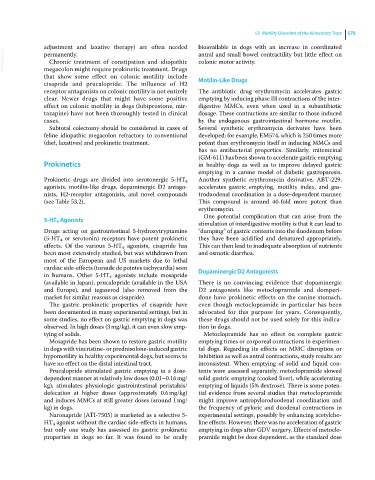Page 611 - Clinical Small Animal Internal Medicine
P. 611
53 Motility Disorders of the Alimentary Tract 579
adjustment and laxative therapy) are often needed bioavailable in dogs with an increase in coordinated
VetBooks.ir permanently. antral and small bowel contractility but little effect on
Chronic treatment of constipation and idiopathic
colonic motor activity.
megacolon might require prokinetic treatment. Drugs
that show some effect on colonic motility include Motilin‐Like Drugs
cisapride and prucalopride. The influence of H2
receptor antagonists on colonic motility is not entirely The antibiotic drug erythromycin accelerates gastric
clear. Newer drugs that might have some positive emptying by inducing phase III contractions of the inter-
effect on colonic motility in dogs (lubiprostone, mir- digestive MMCs, even when used in a subantibiotic
tazapine) have not been thoroughly tested in clinical dosage. These contractions are similar to those induced
cases. by the endogenous gastrointestinal hormone motilin.
Subtotal colectomy should be considered in cases of Several synthetic erythromycin derivates have been
feline idiopathic megacolon refractory to conventional developed; for example, EM574, which is 250 times more
(diet, laxatives) and prokinetic treatment. potent than erythromycin itself in inducing MMCs and
has no antibacterial properties. Similarly, mitemcinal
(GM‐611) has been shown to accelerate gastric emptying
Prokinetics in healthy dogs as well as to improve delayed gastric
emptying in a canine model of diabetic gastroparesis.
Prokinetic drugs are divided into serotonergic 5‐HT 4 Another synthetic erythromycin derivative, ABT‐229,
agonists, motilin‐like drugs, dopaminergic D2 antago- accelerates gastric emptying, motility index, and gas-
nists, H2‐receptor antagonists, and novel compounds troduodenal coordination in a dose‐dependent manner.
(see Table 53.2). This compound is around 40‐fold more potent than
erythromycin.
One potential complication that can arise from the
5‐HT 4 Agonists
stimulation of interdigestive motility is that it can lead to
Drugs acting on gastrointestinal 5‐hydroxytryptamine “dumping” of gastric contents into the duodenum before
(5‐HT 4 or serotonin) receptors have potent prokinetic they have been acidified and denatured appropriately.
effects. Of the various 5‐HT 4 agonists, cisapride has This can then lead to inadequate absorption of nutrients
been most extensively studied, but was withdrawn from and osmotic diarrhea.
most of the European and US markets due to lethal
cardiac side‐effects (torsade de pointes tachycardia) seen Dopaminergic D2 Antagonists
in humans. Other 5‐HT 4 agonists include mosapride
(available in Japan), prucalopride (available in the USA There is no convincing evidence that dopaminergic
and Europe), and tegaserod (also removed from the D2 antagonists like metoclopramide and domperi-
market for similar reasons as cisapride). done have prokinetic effects on the canine stomach,
The gastric prokinetic properties of cisapride have even though metoclopramide in particular has been
been documented in many experimental settings, but in advocated for this purpose for years. Consequently,
some studies, no effect on gastric emptying in dogs was these drugs should not be used solely for this indica-
observed. In high doses (3 mg/kg), it can even slow emp- tion in dogs.
tying of solids. Metoclopramide has no effect on complete gastric
Mosapride has been shown to restore gastric motility emptying times or corporeal contractions in experimen-
in dogs with vincristine‐ or prednisolone‐induced gastric tal dogs. Regarding its effects on MMC disruption or
hypomotility in healthy experimental dogs, but seems to inhibition as well as antral contractions, study results are
have no effect on the distal intestinal tract. inconsistent. When emptying of solid and liquid con-
Prucalopride stimulated gastric emptying in a dose‐ tents were assessed separately, metoclopramide slowed
dependent manner at relatively low doses (0.01–0.16 mg/ solid gastric emptying (cooked liver), while accelerating
kg), stimulates physiologic gastrointestinal peristalsis/ emptying of liquids (5% dextrose). There is some poten-
defecation at higher doses (approximately 0.6 mg/kg) tial evidence from several studies that metoclopramide
and induces MMCs at still greater doses (around 1 mg/ might improve antropyloroduodenal coordination and
kg) in dogs. the frequency of pyloric and duodenal contractions in
Naronapride (ATI‐7505) is marketed as a selective 5‐ experimental settings, possibly by enhancing acetylcho-
HT 4 agonist without the cardiac side‐effects in humans, line effects. However, there was no acceleration of gastric
but only one study has assessed its gastric prokinetic emptying in dogs after GDV surgery. Effects of metoclo-
properties in dogs so far. It was found to be orally pramide might be dose dependent, as the standard dose

